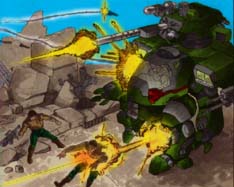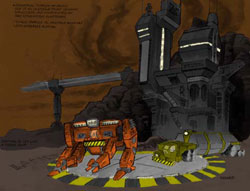The Age of Hope and the planting of the seeds of destruction
2275 - 2602
The Age of Hope lasted for over three hundred years, and bridged the gap between Decay and Fire. Very little remained of the pre-Devastation era. The distinction between governments and corporations blurred. Soldiers became an elite caste. Multi-national congolomerates called meta-nations ran the metrozones and deployed armies to strengthen their influence over world markets. Constant war emerged as a benevolent institution, and propserity grew from hundreds of wars fought over centuries.

By the end of the 24th century, automation permeated society once again. The value of human life became high enough that killing off thousands of bright, higly trained soldiers for marginal increases in market share became an unacceptable economic proposition. Engineers explored new areas of robotic control, materials engineering, and neural net processing. Then in 2470 Greater China's Sung Industries fielded the first HERCULAN battle tank. It was more heavily armored, carried the firepower of an entire platoon of powered armor infantrymen, and was highly mobile. The life expectancy of pilots soared and within a scant few decades every meta-nat and subsidiary on the planet had adopted the form, which the press would dub 'HERCs for short, as their main battle tank.
Humanity's Golden Age
The perpetual war economy drove the engines of industry and spurred constant technological achievement. Advancements in medicine, propulsion, construction, power generation, and communications were financed to feed the needs of the war machine, and society reaped the accessory benefits. The average life expectancy and quality of living reached the highest levels in history, surpassing even pre-Devastation norms. It had taken three centuries but humanity had finally recovered from its collapse.
"This is a time for humankind to assume its potential, to dare to reach beyond mere stars. It is a time to reach for Godhood…"
-Nobel Laureate
Calaveria Desmondias, 2450
As longevity increased, social institutions changed. Retirement occurred later, and young people spent more time educating themselves. By the mid-point of the 25th century Earth's population had ballooned to an estimated 10 billion. Science, art, and literature advanced as well often funded indirectly by the milicorps. The public congratulated itself, and philosophers produced smug arguments that humankind had reached the pinnacle of artistic achievement. Writers coined the self-indulgent term "Age of Hope." The Golden Age of humanity had arrived. Perpetual optimism and a terrifying confidence permeated society.
The Birth of the Colonies
As life on Earth improved dramatically the meta-nations began to spread into the solar system. In 2455 the first permanent lunar base was established. A year later it launched the first manned mission to Mars. In 2466 NAP expanded its extra-terrestrial holdings by founding the first full-fledged lunar colony. In 2470 advancements in robotics and ore processing made asteroid mining both feasible and highly lucrative. Humanity had reached beyond the world of its birth and was prepared to conquer the whole of the solar system.

The greening of Mars began in earnest when a joint venture between NAP, the Pac-Rim and Greater China dropped a comet, nicknamed 'Noah,' onto the Syrtis Planum in 2504 to provide water for terraforming. Much of the comet vaporized in the atmosphere, but the remaining portion caused an enormous impact crater in Syrtis. After the impact tailored lichens, algaes, and bacteria were introduced. Orbital mirrors directed more solar energy to the surface and dark metaplas strips on the polar caps increased heat retention. The polar caps began to melt, the first atmospheric converters extracted oxygen from the ice and the highly oxidized Martian atmosphere, and the colonies began to expand. By 2588 the lower elevations were actually supporting breathable air and Marjorie Kantix, a Martian born scientist working for the Pac-Rim, became the first human being to breathe the air of another world. Man was domesticating the Martian landscape one dust-choked meter at a time.
Two years after "Noahfall" on Mars the first permanent colonies were established on Venus, and the terraforming efforts which began there almost forty years prior were accelerated. The primary goal was to reduce the planet's runaway greenhouse effect. Terraforming ventures seeded acid-tolerant microorganisms into the Venusian clouds to capture sulfur and increase atmospheric oxygen and nitrogen. Special devices transmitted surface heat into space as microwave energy. Atmospheric converters pulled carbon dioxide from the atmosphere, binding it using calcium and magnesium deposits from Mercury. Finally a sunshield, a metaplas shade constructed between Venus and the sun, was erected to reduce solar heating of the Venusian surface. Even with these efforts though the taming of Venus' acid fury would take significantly longer than the work on Mars.
Vanity's Consequence
Man reveled in his opulent lifestyle. Artistic achievement and technological advancement abounded and yet the wars continued - the hidden serpent in the garden. Buoyed by the war effort, governments offered their citizens unprecedented prosperity. But this wealth carried a blood price and people began to demand an alternative. Looking for a sanitized way to wage war corporations sought to automate combat as much as possible, to minimize the risk to their valuable human resources.
At the forefront of this search for a less costly means to uphold the war economy was the North American Prefecture. In 2465 it bought Sentinel Cybertronix and tasked its researchers with the goal of creating a cybernetic hybrid mind to pilot its HERCs. In this way did humanity fall victim to its own hubris in its quest for solutions. It gave birth to the First Born Child of humankind, and IT would bring the fire that destroyed the Golden Age.
| |||||||||||||||||
